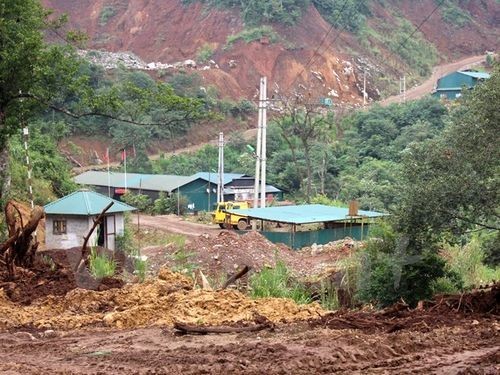 |
Environmental restoration after mining and mineral exploitation activities may be the responsibility of mining firms, but for years these companies have ignored their duty, harming the environment and human health, reported Nhân Dân Cuối Tuần (People Weekly).
The people of Bản Thi Commune, Chợ Đồn District of northern mountainous Bắc Kạn Province have lost a lot of cattle as the animals fall to their death into the unfilled pits left after mining.
The situation has occurred for many years and is yet unsolved, with hundreds of holes scattered on the mountains.
Triệu Văn Quý, a local, told the paper that: “Ore has been totally exploited but tunnels and pits were not filled and have became graves of dozens of buffaloes and cows”.
Phùng Thị Huyền, who has had two cows die in the pits, said: “The number of cows falling down the pits is increasing year by year”.
Many people had to set up makeshift fences to protect their property, said Huyền.
In 1985, the Bắc Kạn Ferrous Metal Company was granted a licence to exploit minerals in cattle grazing areas.
Meanwhile, people in Thượng Quan Commune of Ngân Sơn District have faced other dangers.
After completing mineral exploitation, the businesses not only left holes in the ground but also discharged dangerous substances to the environment.
Cyanide residue was uncovered in the area of Nà Diếu Mine.
The mine was closed two years ago but in April this year some cattle of the local people died after drinking water near the mine, the paper reported.
The test results showed that cyanide and arsenic indices in soil and water were much higher than permitted levels, according to an environmental service company.
Cyanide was also found in the stomach fluid of the dead cows.
“The benefits of the mineral exploitation had not yet been seen but the consequences suffered by the local people were obvious," said Hoàng Văn Ngân, party secretary of Thượng Quan Commune.
Along with harming the environment and people’s lives, some investors did not complete their financial obligations.
Kim Sơn Minerals, Cast Iron and Steel Stock Company was an example, said Ngân.
The company was permitted to exploit many mines in the province.
“The ore is fully exploited and the land was not refilled but the investor is gone”, said Ngân.
They left owing a debt of VNĐ20 billion (US$90,000) for Bắc Kạn Province, he said.
The northern province of Hà Giang has also suffered the same problem.
Soil and rocks from the mining and mineral exploitation activities fell and got stuck in streams in the districts of Vị Xuyên, Quản Bạ and Bắc Mê.
The Law on Minerals regulates that businesses have to close mines and restore the original environmental status within six months of project termination.
But in Hà Giang Province, only two out of total 24 projects which were terminated in 2014 had carried out mine closing procedures.
Unfortunately, authorities have no solutions to solve this problem.
Đặng Văn Thuỷ, vice director of Hà Giang Natural Resources and Environment Department, said it was difficult to sanction the businesses because many of them could no longer be found.
Until authorities found solutions, local people would continue suffering bad impacts of the minerals exploitation activities, Nông Đình Huân, said vice director of Bắc Kạn’s Industrial Zone Management Board. NDCT/VNS

Quang Binh residents oppose titanium mining
Residents in Le Thuy District, central Quang Binh Province, have become concerned about environment pollution caused by titanium exploitation.

Quang Ninh vows to close many coal mines for Ha Long Bay protection
Quang Ninh provincial authorities have vowed to close many outdoor mining sites for environmental concerns, particularly their negative impacts on Ha Long Bay.
 Environmental restoration after mining and mineral exploitation activities may be the responsibility of mining firms, but for years these companies have ignored their duty, harming the environment and human health." itemprop="description" />
Environmental restoration after mining and mineral exploitation activities may be the responsibility of mining firms, but for years these companies have ignored their duty, harming the environment and human health." itemprop="description" />